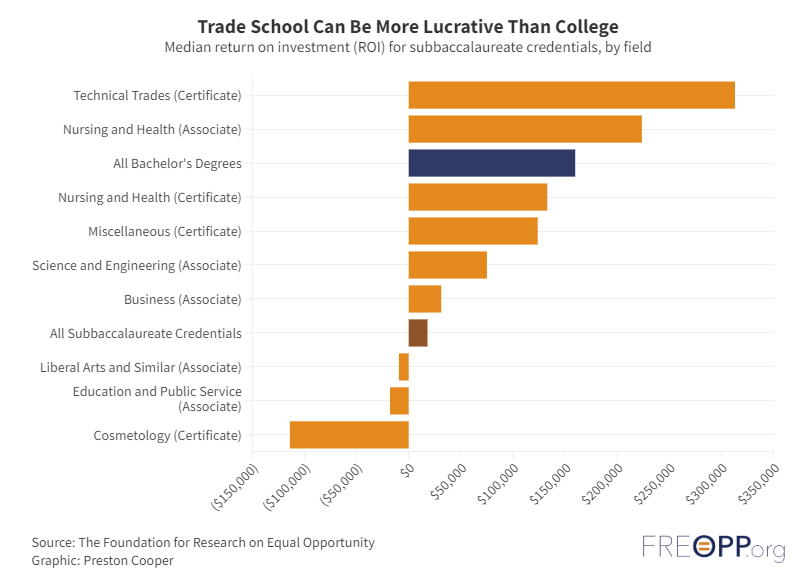High school graduates have many educational opportunities and some pay more than ever
Market factors like artificial intelligence are reconfiguring the workforce, leading many recent high school graduates to consider apprenticeships, trade schools, technical colleges and additional cost-saving methods for achieving degrees. Gen Z wants to be certain that their investments of time and money will pay off. Between constantly evolving technology, the cost of education, and the truly countless paths available to students today, there are many paths for success.
Future outcomes are forged between the ages 14-24, a time known as the “decisive decade.” During this period students navigate from one growth opportunity to another and experience brain development around decision making and risk-taking to help shape their futures.1 The conventional tradition is “you graduate from high school and go to a four-year university.” That wisdom doesn’t reflect current data or career outcomes, as seen in the following research on ROI across various paths to higher education.
Specialized trades are offering solid skills and high starting salaries
The promises of trade school are working. The National Student Clearinghouse Research Center found student enrollment in vocational-focused (rather than transfer-focused) community colleges jumped by 17.6% from 2023 to 2024, on top of a 4% increase the prior year.2 Additionally, people who complete a registered apprenticeship earn an average starting salary of $80,000 and have a lifetime earning average of $300k over peers who don’t.3
Trade positions work well for individuals who are entrepreneurial and capable of promoting their services through social media and local marketing. If you have recently hired anyone for a renovation, you know that quality work generates enough positive word of mouth to book out months in advance, allowing tradespeople to control their calendars and benefit directly from their overtime efforts. Plus, students can earn money while attending apprenticeship programs, creating a longer runway for saving goals like retirement and their children’s 529 plans.
Technical colleges deliver strong ROI
Gen Z prioritizes staying ahead of the AI learning curve to ensure their educational investments keep up with — and survive — technology improvements. Technical colleges help students learn entry-level skills, while also achieving higher average wages. The Foundation for Research on Equal Opportunity found “median ROI for the technical trades is $313,000, compared to just $160,000 for the median bachelor’s degree. Two-year degrees in nursing and other health professions also boast a strong median ROI of $224,000.”4
The Utah Foundation examined long term value of higher education programs over 40 years and Neumont College of Computer Science surpassed all other Utah schools.5 Attending a technical college allows students to skip general education classes and jump straight to building on marketable skills, empowering them to take on paying projects or internships simultaneous to completing their coursework, all while still enjoying the social and extracurricular opportunities a school campus offers.
Not all four-year degrees break even, but some majors offer dependable returns
Four-year universities are seeing their enrollment numbers drop and are concerned about continuing to attract new students, but they aren’t dead yet! With careful consideration, students can choose an undergraduate major that will reliably pay off.
A recent Salt Lake Tribune study of 656 occupations across 22 industries tracked earnings over an individual’s career and the range is significant. Over a 20-year career, these numbers accumulate to a range of $577,408 to $1,962,883. In addition to illustrating the benefits of a bachelor’s degree, the Tribune study also reinforced that not every well-paying job requires a bachelor’s degree. “An associate’s degree can also be lucrative in the health care field — like magnetic resonance imaging technologists, who make a median annual wage of $78,000.”6
Not all degrees are equal, but regardless of degree choice, starting at a community college can help boost returns by keeping costs low. Not only do students have the opportunity to experience greater variety during their education, but the final diploma will be no different — and cost less. Attending summer school at community college or earning college credit during high school can shave off semesters or help a student narrow their academic focus.
When it comes to ROI on coursework, we want your time and money to result in credits you can use toward your certification or diploma. Classes that aren’t completed or don’t apply to your ultimate degree may be the costliest.
How long until you can expect to break even?
Higher education is an expensive endeavor, but the rewards exceed purely financial gains to include intellectual, social and societal benefits. Those qualitative factors are important to consider and thanks to some insightful tools, you can compare some of the quantitative variables.
The Foundation for Research on Equal Opportunity did extensive reporting on the rate of return across various certificates and degrees, and you may find their interactive graphs helpful. You can utilize the drop downs to isolate the majors you are considering and see the dispersion of earnings, including what percentage of those degree owners never achieve a positive ROI.7 If you wish to explore these resources, they can be found in the endnotes.
Students can also explore average outcomes across specific majors at various schools with Georgetown University’s ROI calculator.8 Paired with the my529 College Savings Estimator tool, students can use these resources to capture a clear picture of anticipated total costs against the predicted future earnings of individual programs. This will help ensure that their investments of time and money are well spent, as almost one third of higher education students are enrolled in programs that are unlikely to pay off.
[1] Smith, Ember, and Richard V. Reeves. 2024. “The Decisive Decade: Understanding the Trajectories of 14- to 24-year-olds.” Brookings, April 26, 2024. https://www.brookings.edu/articles/the-decisive-decade-understanding-the-trajectories-of-14-to-24-year-olds/.
[2] “Current Term Enrollment Estimates | National Student Clearinghouse Research Center.” 2024. May 22, 2024. https://nscresearchcenter.org/current-term-enrollment-estimates/.
[3] Apprenticeship, Office Of. 2024. “Apprenticeship.gov.” Apprenticeship.Gov. August 5, 2024. https://www.apprenticeship.gov/.
[4] “Does College Pay off? A Comprehensive Return on Investment Analysis – FREOPP.” 2024. FREOPP. May 31, 2024. https://freopp.org/does-college-pay-off-a-comprehensive-return-on-investment-analysis-563b9cb6ddc5.
[5] “Bang for Your Buck: Which Utah Schools Have the Best Return on Investment – Utah Foundation.” 2023. Utah Foundation. August 29, 2023. https://www.utahfoundation.org/reports/bang_for_your_buck_return_on_investment/.
[6] The Salt Lake Tribune. 2024. “These College Majors Give Utah Students the Most (and Least) Returns Over Their Career,” May 2, 2024. https://www.sltrib.com/news/2024/05/02/picking-college-major-heres-how/.
[7] “Does College Pay off? A Comprehensive Return on Investment Analysis – FREOPP.” 2024. FREOPP. May 31, 2024. https://freopp.org/does-college-pay-off-a-comprehensive-return-on-investment-analysis-563b9cb6ddc5.
[8] “A First Try at ROI: Ranking 4,500 Colleges – CEW Georgetown.” 2024. CEW Georgetown. May 8, 2024. https://cew.georgetown.edu/cew-reports/collegeroi/.




